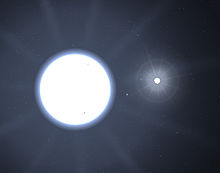Celestia
![]()
This article is about the computer program. For the main belt asteroid of the same name, see (1252) Celestia.
Celestia is a 3D astronomy program for Windows, macOS, FreeBSD and Linux, developed by Chris Laurel. It is open source and GPL licensed. Since October 20, 2008 there is also a portable version available from PortableApps. As for the standard version, there is a German language pack for the portable version on the German Celestia website.
The program allows users to simulate objects ranging in size from the International Space Station to galaxies like the Milky Way in three dimensions. The program uses OpenGL as its 3D library. Unlike normally with planetarium software, the user is able to move freely through the universe. In this and other features it is similar to the program Space Engine.
NASA and ESA have recognized the potential of Celestia and used it for their own demonstration purposes (see web links). Not to be confused with Celestia is ESA's own program Celestia 2000, which is now used by ESA in a separate program (Space Trajectory Analysis) for analysis, simulation and visualization of trajectories.
The Institute of Space Systems at the University of Stuttgart uses Celestia as a live visualization for the system simulation infrastructure built in cooperation with EADS Astrium in the context of satellite development. The system simulation infrastructure OpenSimKit used for teaching at the institute also represents the simulated rocket upper stage with Celestia.
Starting with version 1.3.1 Celestia is also offered as a German language version.
In early August 2016, Celestia maintenance and support was taken over by a Russian Celestia enthusiast and the user forum was reactivated.
Functions
- "Guidebook" (collection of some important places in the solar system).
- Solar and lunar eclipse calculator for all planets up to the year 9999.
- The Hipparcos catalog (120,000 stars) is included in the basic program.
- It is possible to take screenshots as well as record the moving action on the screen as a video.
- Time can be set arbitrarily far into the future or past.
- Constellations and orbits of planets, moons, asteroids, comets and satellites can be displayed.
- The names of all objects in space can be displayed: Galaxies, clusters, stars, planets, moons, asteroids, comets, satellites.
- The names of cities, impact craters, observatories, valleys, landing points, continents, mountains and lakes can be displayed.
- The radius, distance, day length and average temperature of the planets are displayed.
- Of stars, the distance, luminosity compared to the Sun, class, surface temperature, radius, and orbital period are displayed.
- The number of visible stars can be varied.
- The field of view can be varied continuously.
- The apparent brightness of the stars can be adjusted in three steps
- The image can be split to observe several objects at the same time.
- The speed of light can be ignored or taken into account.
- Gamepad support
Restrictions
- The default setting for the earth is a perfect sphere. To display the earth correctly, this must be set in a program file.
- All galaxies and stars are stationary (with the exception of binary star systems, where the center is fixed). Therefore, even with very strong time acceleration, it is not possible to observe a rotation of the galaxy.
- Some double star systems are not yet displayed correctly.

Sirius
Questions and Answers
Q: What is Celestia?
A: Celestia is a free 3D astronomy program for Windows, Mac OS X, and Linux created by Chris Laurel and based on the Hipparcos Catalogue.
Q: What can users do with Celestia?
A: Users can display objects from artificial satellites to entire galaxies in three dimensions in OpenGL and travel freely in the universe.
Q: What is the license under which Celestia is released?
A: Celestia is licensed under the GPL.
Q: How does Celestia differ from other planetarium software?
A: Celestia differs from other planetarium software in that the user is free to travel in the universe, and it allows users to display objects in three dimensions.
Q: Has Celestia been used by NASA and ESA?
A: Yes, NASA and ESA have used Celestia.
Q: Is Celestia to be confused with Celestia 2000?
A: Yes, Celestia is not to be confused with Celestia 2000, which is ESA's own program.
Q: How many stars is the Hipparcos Catalogue?
A: The Hipparcos Catalogue is 120,000 stars.
Search within the encyclopedia